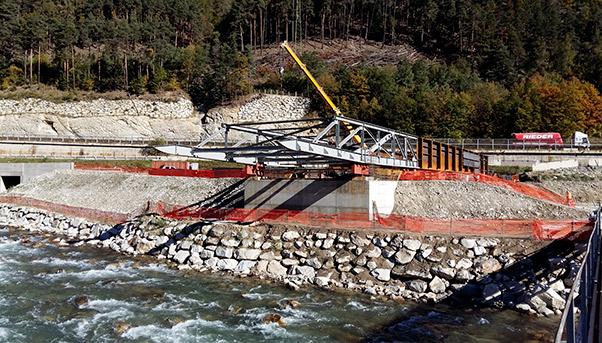The first blow has been struck with a pickaxe to inaugurate the work on the southern end of the Brenner Base Tunnel. It happened on July 12, the first day of construction, in the presence of local and national officials and the heads of BBT SE, the European company that is building the tunnel between Italy and Austria
And so began the excavation of 5.8 kilometres of tunnel from Fortezza, Italy, where the tunnel will go under the Isarco River for about 240 metres, a section of the project considered to be the most technically complex.
The contract, awarded in October 2014 to Isarco Scarl (the consortium led by Salini Impregilo and including Strabag, Collini Lavori and Consorzio Integra), is worth about €301 million and consists of a the first section of the tunnel that will run 55 kilometres in its totality and, by 2025, link Fortezza with Innsbruck, Austria. It is a project of records: when including the Innsbruck railway ring that leads to Munich, it will be the longest railway tunnel in the world at 67 kilometres with many of passages going under mountain peaks 1,000 metres high.
Through this high-capacity tunnel – as it is described technically – passenger and cargo trains will pass, giving an important boost to trade between Italy and the rest of Europe. The passenger trains will be able to reach speeds of 250 kilometres per hour compared with today’s 130-140. The tunnel is strategic also because it is part of the giant European project that aims to unite Verona and Munich. The link is part of the Transeuropean Network (TEN-T) and the 2,200 kilometres planned by the European Union to link Berlin with Palermo.
So the Brenner is a central part of this vision, in which Salini Impregilo is playing a decisive role because, in addition to the southern lot that the Group won with Strabag, it is involved in the €377-million, 37-kilometre section on the other side of the mountains to the north that leads to Innsbruck.
Meanwhile, the attention these days it focused on Isarco because it is where construction has begun.
«The approval of the project that sets off the work is a big result for us», says Nicola Meistro, Salini Impregilo’s project manager. «The Brenner tunnel, and especially in this lot, represents a project that is technically very bold: full of difficulties and challenge».

The biggest is definitely the passage under the Isarco River that will be done by resorting to a freezing technique. «It is a technique that has been used in the past but is still very complicated», says Meistro. «It starts with drilling into ground under the river and injecting a chemical and cement compound that is needed to slow the speed of the water. After that, liquid nitrogen is poured into the bored holes in which it changes to become a gas at 130 degrees (celsius) below zero. The immediate effect of the nitrogen is to freeze everything around the tube in which it is injected for nearly 50 centimetres».
The freezing of the ground between the gallery being excavated and the river above makes the ground waterproof and the rock stable and resistant around the excavation work. Despite its complexity, it is a required application that is made at a number of intervals (four tunnels each 60 metres long) because it is linked to the speed of the water that must not exceed certain limits. The faster the water, the warmer the ground becomes.
But the passage under the Isarco is not the only challenge in a project that makes technical skill and protection of the environment its two strong points. Among the auxiliary works underway, the consortium has planned the construction of an exit on the Brenner highway so that all the material required at the construction site can be moved via the highway without having a major impact on the territory. Skill and experience will also be needed to manage the excavation of the ground, which is made up not just of rock but detritus born out of the passage of the rive or landslides from the mountain. Consolidating this material to make it secure during the construction phase as well as during the operation of the railway represents today another challenge that Salini Impregilo will confront by putting to work the most modern techniques being used in the sector.
So everything is ready at the starting blocks. In addition to the officials and the engineers that conceived the tunnel, there are about 300 workers that will be involved for the next 70 months in the construction of this southern lot. For them, in an age of walls and divisions, work on the “project that unites” like Brenner is not only an engineering feat but also an instrument to bring people closer together and encourage cultural and economic exchange.

